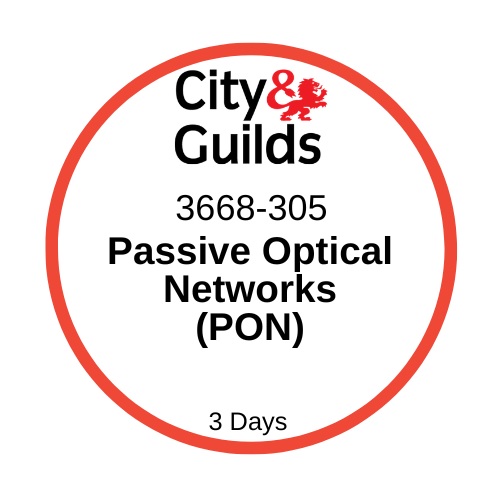CITY AND GUILDS LEVEL 3 COURSE BUNDLES – 3668 – 03, Unit 301, 302 & 305 Level 3 Passive Optical Networks (PON)
£1,284.00 Inc.VAT | £1,070.00 Ex.VAT
CITY AND GUILDS LEVEL 3 COURSE BUNDLES – 3668 – 03, Unit 301, 302 & 305 Level 3 Passive Optical Networks (PON)
The qualification will be referencing the BSEN50173 and BEN50174 series of standards
This is a 5 Day Level 3 Core Modules & Passive Optical Networks (PON) Units 301, 302 & 305 course
The aim of the Passive Optical Networks (PON) Unit 305 is to give delegates the opportunity to carry out the evaluation needed for the deployment of passive optical network technologies and become conversant with terminologies as used in passive optical network systems.
Delegates can use this unit to develop and enhance their underpinning knowledge and understanding that is driving the global deployment of fibre to the home/office between the central office/telephone exchange/head-end and its subscribers using passive optical networks.
Delegates will also be given the opportunity to explore and describe the passive components employed in PON network implementation. There is a practical element to this unit which will cover the key elements of the correct installation practices and the testing of the external cabling to the customer premises.
CORE MODULES:
Unit 301: The aim of this unit is to enable delegates to gain an understanding of the safety, to develop and increase the knowledge required for safety, including safe working practices and behaviours, whether working in an internal network and in the external network, including underground, overhead and the public highway.
Unit 302: The aim of this unit is to enable delegates to gain an understanding of the fundamental of telecoms transmission technologies.
Our training centre is located in Harlow in the South East of England just off the M25. We can also deliver courses at your location by arrangement if you have a suitable workspace.
*use voucher code tct5 at checkout for 5% discount
Description
CITY AND GUILDS LEVEL 3 COURSE BUNDLES – 3668 – 03, Unit 301, 302 & 305 Level 3 Passive Optical Networks (PON)
Course details…
Availability
Dates on request
Duration
5 Days
Eligibility Criteria
PLEASE ensure that you read through the information provided for this training course, including the expectations of candidates, fully before booking – we are here to advise and we welcome you to contact us if you have any questions.
It is aimed at *experienced* Data and Fibre Optic cabling Engineers who are currently installing and testing a full range of class D/Class E/Class EA and MM/SM fibre optic systems and are seeking to obtain a Level 3 Qualification in Network Infrastructure, Enterprise Networks, PON and other systems utilising a range of communications cabling systems.
If your unsure of the route you need we would strongly recommend that you take the City & Guilds 3668 Level 2 qualifcation first. Click HERE for Level 2 details
Course Content
Unit 301: Safe Working Practices and Behaviours:
- Describe the primary safety legislation and safety regulations relevant to the communications cabling and telecommunications industry.
- Describe key factors of health and safety, personal health and wellbeing
- Describe comprehensive risk assessments, method statements and permit to work in all aspects of underground, overhead and internal networks.
- The principles of conducting a site survey
- Describe and produce a plan for a road works guarding configuration set up
- Describe the deployment of road works guarding in accordance with a site plan.
- Confined spaces including underground chamber safety access
- Responding appropriately to emergencies.
- Working at heights including electrical hazards
- Describe and identify asbestos hazards and legal requirements
- Describe and identify the correct fire stopping materials as appropriate
- Describe the SSOW: safe system of work for voltage/metal/stud detection to identify hidden services and the selection of a safe place to drill.
- Describe processes for carrying out effective communication with customers appropriately.
- Describe the processes for effective communication with peers
- Describe the processes for effective communication with manager.
Unit 302: Telecoms Fundamentals:
- Describe the characteristics of transmission technologies
- Describe the applications in digital networks.
- Describe the uses of different types of media associated with data and telecommunications networks.
- Describe the characteristics of different media that are used as part of data and telecommunications networks.
- Describe data transmission methods used as part of data and telecommunications networks.
- Describe the role of the organisations that are responsible for establishing telecoms and data network standards
- Describe the layers of the OSI model and function of each layer, referencing the TCP/IP model.
- Describe the purpose of standards associated with data and telecommunications networks
- Describe the role of protocols in data and telecommunications networks.
Unit 305 Passive Optical Networks
- Describe the uses passive optical network technologies
- Describe the impact of last mile limitations
- Describe the features of passive optical networks
- Describe passive optical network technologies
- Describe the purpose of fibre to home technology
- Describe and identify the fibre to home wavelengths
- Describe the passive optical network topologies
- Describe the purpose of time division multiple access.
- Describe and demonstrate overhead delivery when using components of PON topologies
- Describe and demonstrate underground delivery when using components of PON topologies.
- Describe and explain standards affecting network performance
- Describe the use of proof connectivity technologies
- Carry out a calculation to determine a loss budget for a fibre to home PON system
- Describe the importance of equipment location
- Describe and demonstrate different installation methods
- Describe the purpose of optical network distribution
- Describe the overall PON testing methodology
- Describe and demonstrate the use of test equipment
Assessment
Candidates are individually assessed by a number of timed assignments.
Please note:
All candidates associated assignments are marked internally by a nominated and City and Guilds approved assessor.
These assignments will be subject to a quality audit by the awarding body
Price Breakdown
This course is subject to vat and is inclusive of all examination fees.
Certificates are sent via email as PDF. If you require a Hard Copy Certificate £5.00 P&P is required.
Additional information
| PRODUCT TYPE | TRAINING COURSES, CITY AND GUILDS LEVEL 3 COURSE BUNDLES |
|---|
Related products
Contact Us
Fax: 01322 553922
Bownet Cable Management Systems Ltd.
Registered address:
23 Acorn Industrial Park
Crayford Road
Dartford
Kent DA1 4AL
Registered in England No. 2358940
VAT No. 625 607149
sales@bownet.co.uk
Offices & Trade Counter
Monday - Friday
Useful Information
About Bownet CMS
Safe and Secure









Follow Us: